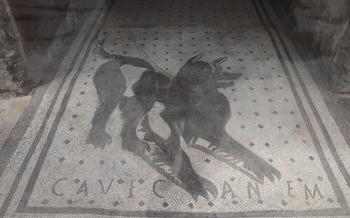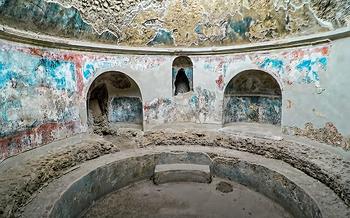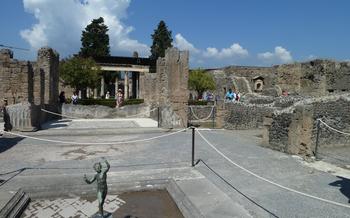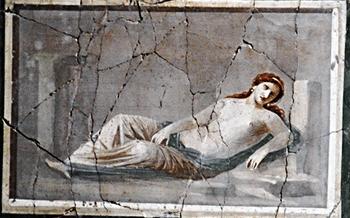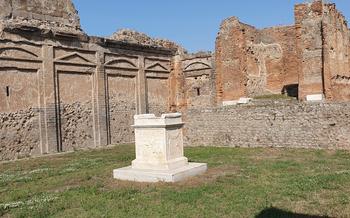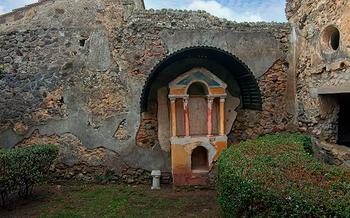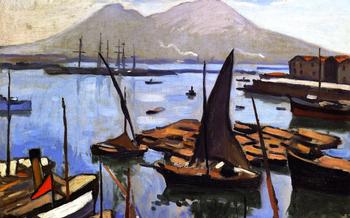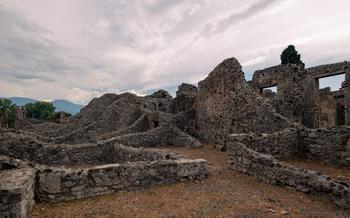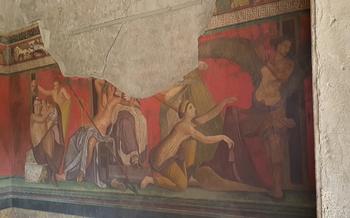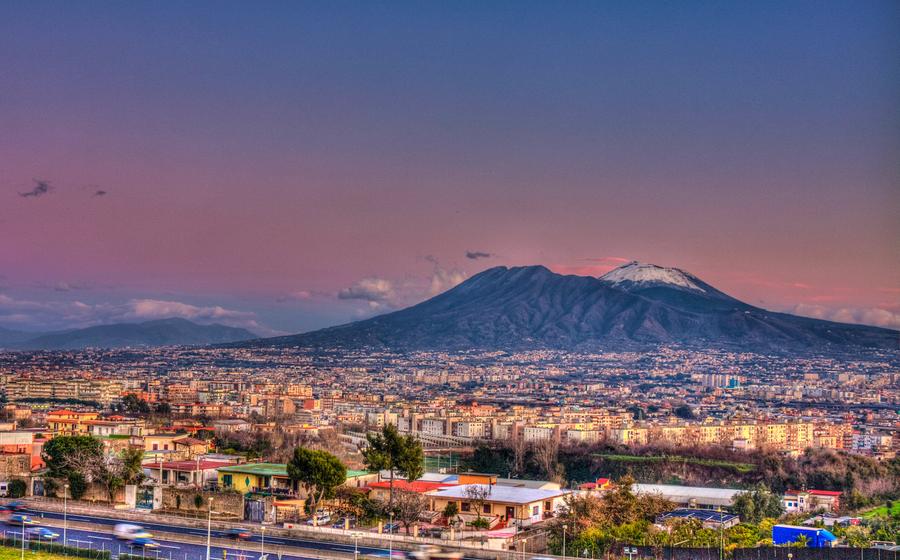
Mount Vesuvius
- Introduction
- Historical Significance:
- Geological Formation:
- Choosing a Tour
- Planning Your Visit to Mount Vesuvius
- Getting to Mount Vesuvius:
- Hiking Trails:
- Pompeii and Herculaneum
- Local Cuisine
- Photography Tips for Capturing Mount Vesuvius' Majesty
- Budget and Cost
- Family-Friendly Activities
- Insider Tip: Unveiling the Hidden Gem of Monte Somma
Introduction
In the heart of Southern Italy's Campania region, nestled between the vibrant city of Naples and the picturesque Sorrento Coast, lies the iconic Mount Vesuvius, a towering natural wonder with a captivating history and enduring significance. As one of the world's most famous volcanoes, its slopes hold tales of devastation and rebirth, shaping the region's landscape and leaving an indelible mark on human civilization. From its humble beginnings as a fertile mountain revered by ancient civilizations to its cataclysmic eruption in 79 AD that buried the Roman cities of Pompeii and Herculaneum, Mount Vesuvius stands as a testament to the power of nature and the resilience of the human spirit.
Historical Significance:
Mount Vesuvius is not just a natural wonder; it also holds immense historical significance. In 79 AD, the volcano erupted with catastrophic force, burying the ancient Roman cities of Pompeii and Herculaneum under layers of ash and pumice. This cataclysmic event forever altered the course of Roman civilization and left an indelible mark on history. The ruins of these once-thriving cities, remarkably preserved by the volcanic material, now offer a fascinating glimpse into the lives and culture of the ancient Romans. Exploring these archaeological sites allows us to connect with the past and learn from the resilience and tragedy of those who lived in the shadow of Mount Vesuvius. It's a poignant and humbling experience that adds depth and context to our understanding of this iconic volcano.
Geological Formation:
Mount Vesuvius is an active volcano, and one of the most dangerous in the world. It is located in the Campania region of southern Italy, near the city of Naples. Vesuvius is a stratovolcano, composed of layers of lava and ash that have built up over time. The volcano has a central crater that is about 2 miles wide and 1 mile deep.
The volcanic activity of Mount Vesuvius is caused by the subduction of the African Plate beneath the Eurasian Plate. This process causes the African Plate to melt, and the magma rises to the surface to form volcanoes. Vesuvius is one of the most active volcanoes in Europe and has erupted many times throughout history. The most famous eruption of Vesuvius was in 79 AD, when it buried the Roman cities of Pompeii and Herculaneum. The eruption was caused by a buildup of pressure in the volcano's magma chamber. The pressure eventually became too great and the magma exploded out of the volcano, sending ash and pumice into the air. The eruption lasted for several days and completely destroyed Pompeii and Herculaneum.
Choosing a Tour
When planning your visit to Mount Vesuvius, choosing the right tour can greatly enhance your experience. Several tour options are available, each catering to different preferences and budgets.
Guided Group Tours: Guided group tours are an excellent option for those who prefer a structured and informative experience. These tours typically include transportation from Naples, a knowledgeable guide who provides commentary and insights, and entrance fees to Mount Vesuvius. They often have fixed departure times and group sizes, making them a convenient and social option.
Private Guided Tours: For a more personalized and exclusive experience, consider booking a private guided tour. These tours offer greater flexibility in terms of departure times and itineraries, allowing you to customize your visit according to your interests and pace. Private guides can tailor their commentary to your specific questions and provide a more immersive experience.
Self-Guided Tours: For independent travelers who prefer to explore at their own pace, self-guided tours are a viable option. You can purchase entrance tickets at the visitor center and follow the well-marked trails on your own. Audio guides and guidebooks are available for rent to provide additional information and context.
Planning Your Visit to Mount Vesuvius
The best time to visit Mount Vesuvius is during the spring (April-May) or autumn (September-October) when the weather is pleasant and the crowds are smaller. Summer months can be hot and crowded, especially in July and August, making the hike more challenging. During winter, the trails may be covered in snow or ice, requiring proper gear and precautions.
Before your visit, check the official website of the Vesuvius National Park for any closures or restrictions due to weather conditions or volcanic activity. The park typically opens at 9:00 AM and closes around sunset. Plan to spend at least two to three hours for the entire experience, including the hike, exploring the crater, and taking in the views.
Getting to Mount Vesuvius:
To reach Mount Vesuvius from Naples, you have several transportation options. The most convenient way is to join a guided tour, which typically includes round-trip transportation from Naples. If you prefer to travel independently, you can take the Circumvesuviana train from Naples to Pompeii Scavi station, which takes about 35 minutes. From there, you can catch a local bus or taxi to the entrance of the Vesuvius National Park.
If you're driving, take the A3 motorway towards Salerno and exit at Torre del Greco. Follow the signs to Ercolano and then to Vesuvius. The drive takes about 45 minutes. Once you arrive at the park entrance, you can purchase tickets and choose your hiking trail.
Remember to bring comfortable shoes, water, and sunscreen, as the hike can be strenuous and exposed to the sun. Also, check the weather forecast before your visit, as the trails might be closed in case of adverse weather conditions.
Hiking Trails:
Mount Vesuvius offers various hiking trails, each with its unique challenges and rewards. The most popular trail, the Gran Cono Trail, leads directly to the summit and provides stunning views of the crater and surrounding landscapes. The trail begins near the ticket office and takes you through diverse terrain, including lush forests, volcanic rock fields, and the barren slopes of the volcano. For those seeking a more challenging experience, the Bocca del Silenzio Trail offers a steep climb to the crater's edge, while the Cognoli Trail takes you through the lush vegetation of the volcano's southern slopes. Regardless of your fitness level, choosing a trail that suits your abilities and interests is essential. The trails are well-marked, but hiking boots and comfortable clothing are recommended, and it's always advisable to bring water and snacks. The breathtaking views and the sense of accomplishment make the effort of hiking Mount Vesuvius worthwhile.
Pompeii and Herculaneum
While visiting Mount Vesuvius, don't miss the chance to explore the ancient Roman cities of Pompeii and Herculaneum, which were buried by the catastrophic eruption of 79 AD. These remarkably preserved cities offer a glimpse into the lives of the Romans and the devastating impact of the volcano.
Begin your journey in Pompeii, a sprawling city that once bustled with life. As you wander through the remarkably well-preserved streets, you'll encounter ancient ruins, including temples, theaters, shops, and homes. Gaze upon intricate mosaics, frescoes, and sculptures, which provide a glimpse into the artistic and cultural achievements of the Roman Empire.
Herculaneum, though smaller than Pompeii, is equally fascinating. This seaside town was once a wealthy retreat for the Roman elite. Explore the remarkably well-preserved villas, adorned with stunning frescoes and mosaics. The town's proximity to the sea has contributed to the preservation of organic materials, including wooden furniture, food, and even human remains, providing an unparalleled glimpse into everyday life in ancient Rome.
Visiting both Pompeii and Herculaneum is a profound experience that combines history, archaeology, and a sense of awe. Immerse yourself in the past as you walk through these ancient cities, forever frozen in time by the volcanic eruption.
Local Cuisine
When visiting Mount Vesuvius, take the opportunity to savor the delectable Neapolitan cuisine. The region is renowned for its mouthwatering pizzas, prepared with fresh, local ingredients and baked in wood-fired ovens to perfection. Indulge in a traditional Margherita, topped with San Marzano tomatoes, creamy mozzarella cheese, and fragrant basil, or try the Marinara, a simpler version with just tomatoes, garlic, and oregano.
Beyond pizza, Neapolitan cuisine offers a wealth of culinary delights. Sample the spaghetti alle vongole, a pasta dish featuring succulent clams in a white wine sauce, or the frittura di pesce, a platter of fried seafood that showcases the region's fresh catch. For a taste of local street food, try the cuoppo, a paper cone filled with fried goodies like calamari, shrimp, and potato croquettes.
To satisfy your sweet tooth, don't miss the sfogliatelle, a delicate pastry filled with a sweet ricotta cheese filling, or the babà, a rum-soaked cake that's a local favorite. And of course, no meal in Naples is complete without a cup of strong, aromatic espresso.
Insider Tip: For an authentic Neapolitan dining experience, head to L'Antica Pizzeria da Michele, a legendary pizzeria that has been serving up mouthwatering pizzas since 1870. Be prepared to queue, as this popular spot is a favorite among locals and tourists alike.
Photography Tips for Capturing Mount Vesuvius' Majesty
When capturing the grandeur of Mount Vesuvius, preparation is key. Arrive early to catch the golden hues of sunrise or stay late for the warm, ambient light of sunset. Consider the weather conditions: clear skies offer stunning views, while clouds can add drama and mystery to your shots.
Choose the right lens: a wide-angle lens will allow you to capture the scale of the volcano against the surrounding landscape, while a telephoto lens will enable you to zoom in on specific features or eruptions. Use a tripod to ensure sharp images, especially when using a telephoto lens.
Experiment with different angles: shoot from various vantage points to create unique compositions. Look for foreground elements, such as trees, rocks, or people, to add depth and interest to your shots. Pay attention to the light: side lighting can highlight the volcano's textures and contours, while backlighting can create a dramatic silhouette.
Don't forget about the details: zoom in to capture the unique textures of the lava flows or the wisps of smoke rising from the crater. Be patient: the perfect shot may take time, so enjoy the experience and don't rush your photography.
Budget and Cost
Visiting Mount Vesuvius and its surrounding areas can vary in cost depending on your preferences and budget. Here's a breakdown of the approximate expenses to expect:
-
Entrance Fees: The entrance fee to Mount Vesuvius National Park is around €10-€15 per person, depending on the time of year.
-
Guided Tours: Guided tours of Mount Vesuvius typically range from €20 to €40 per person. These tours usually include transportation to and from the volcano, a guided ascent to the crater, and informative commentary about the history and geology of the site.
-
Transportation: If you choose to drive to Mount Vesuvius, you can expect to pay parking fees, which vary depending on the location and duration of your stay. Alternatively, you can take public transportation from Naples, which costs approximately €10-€15 round trip.
-
Food and Drinks: There are limited food and beverage options available on Mount Vesuvius, so it's advisable to bring your own snacks and water. If you wish to dine in the surrounding area, you can find restaurants offering traditional Neapolitan cuisine with meals ranging from €10 to €30 per person.
-
Additional Expenses: Consider budgeting for additional expenses such as souvenirs, postcards, or photography permits, which can vary in price depending on your preferences.
-
Overall Budget: To give you a rough idea, a day trip to Mount Vesuvius, including transportation, guided tour, entrance fees, and basic meals, can cost approximately €50-€70 per person. However, this can be adjusted based on your choice of transportation, dining options, and any additional activities or souvenirs.
Family-Friendly Activities
Mount Vesuvius offers a range of family-friendly activities that cater to the interests of children and adults alike. Educational programs conducted by experienced guides bring the fascinating history and geology of the volcano to life, captivating young minds with interactive demonstrations and hands-on activities. These programs often include engaging storytelling, multimedia presentations, and the opportunity to examine volcanic rocks and minerals firsthand.
Guided tours tailored specifically for families ensure a safe and enjoyable experience for all members. These tours typically incorporate shorter hiking distances, slower paces, and frequent rest stops to accommodate the needs of younger visitors. Experienced guides provide age-appropriate commentary, keeping children engaged with fun facts, trivia, and interactive games related to the volcano and its surroundings.
Interactive exhibits located at the base of Mount Vesuvius offer a hands-on learning experience for families. These exhibits feature interactive displays, touchscreens, and multimedia presentations that allow children to explore the volcano's history, eruptions, and impact on the region. Educational games and puzzles further enhance the learning experience, making it both fun and informative for young visitors.
Insider Tip: Unveiling the Hidden Gem of Monte Somma
Venture beyond the summit of Mount Vesuvius and discover the hidden gem of Monte Somma, an ancient caldera that once formed the original cone of the volcano. Hike along the scenic trails that wind through lush forests, offering breathtaking views of the surrounding landscapes, including the Bay of Naples and the island of Capri. Explore the ruins of ancient settlements, including the remains of a Roman villa, and immerse yourself in the rich history of this remarkable site. Monte Somma provides a unique and serene experience, away from the crowds, allowing you to delve deeper into the geological and historical wonders of the region.
